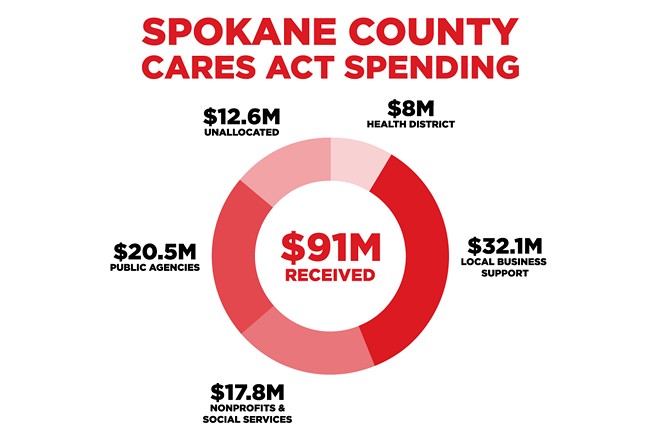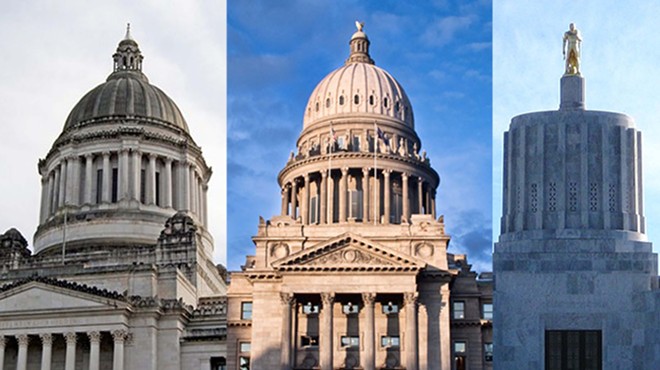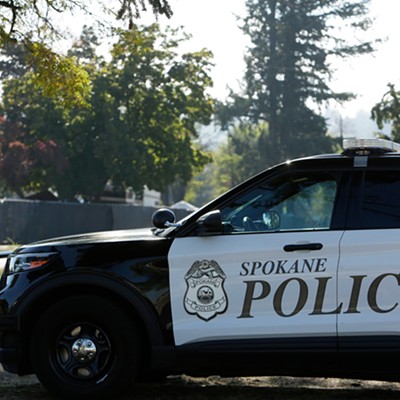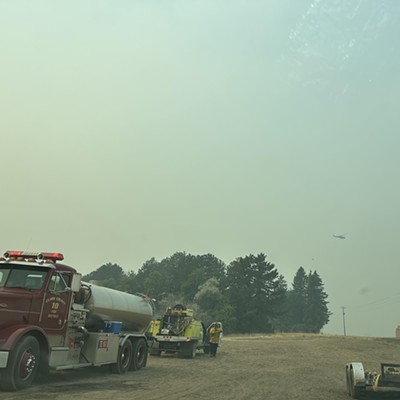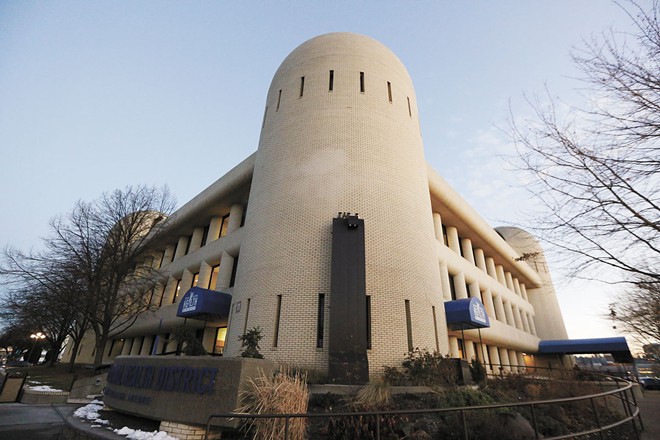
As COVID-19 made its first wave across the country, and schools and businesses shut down, Congress passed the CARES Act this spring in an effort to dampen the economic fallout of the pandemic.
Spokane County received about $91 million from the $2.2 trillion stimulus bill, signed by President Donald Trump on March 27. That meant that three Spokane County commissioners — Republicans Al French, Josh Kerns and Mary Kuney — got to decide how to dole out money to affected businesses, government agencies and nonprofits. The money has to be spent by the end of this year.
Thus far, the commissioners have taken a methodical approach. A breakdown of the county's CARES spending, provided to the Inlander, reveals that the largest chunk — about $32 million — has gone toward supporting and promoting businesses. Another chunk, roughly $18 million, has supported nonprofits, particularly those providing food assistance like Second Harvest. The rest has been devoted to government agencies like the Spokane Regional Health District, public school systems and various county government operations.
"My biggest priorities were food security, and then making sure that the health district had the funding they needed, as far as the COVID response," Kerns says. "And then, finally, it was supporting our small businesses."
The county has received criticism for how it's used CARES money. Some community advocates, worried about a looming tsunami of evictions once the state moratorium is lifted, have pushed for rental housing assistance, but commissioners have not used any of the $91 million for that. And with the Dec. 30 deadline for allocating CARES funding fast approaching, the county still has more than $12.6 million left to spend or it would need to be returned to the federal government.
Here's a more detailed breakdown of where the money has gone so far.
HEALTH DISTRICT
The first chunk of the county's CARES money was $6 million that went to the Spokane Regional Health District on June 2. The health district requested the money to pay for costs associated with contact tracing, testing, equipment, an isolation center, and assistance for businesses and long-term care centers.
Following the initial request, the health district — led by administrator Amelia Clark — came back and asked for $2 million more, which the county granted on July 20.
But the health district, as the Inlander reported last month, has still made cuts to multiple programs and laid off employees, despite the added CARES funding. Commissioner Kuney, also on the health district board, says those cuts reflect budgeting for next year, when CARES money won't be available unless the deadline to use it is extended. She adds that the health district has not asked for any more funding since July.
"That's all they've asked for at this point," Kuney says. "We're constantly talking to them and figuring out if they need additional funding."
Kerns says that if Clark asked for more money for the health district, he would support giving it to her.
BUSINESSES
Supporting businesses impacted by COVID-19 shutdowns has been a major focus of the county's CARES funding. In June, commissioners dedicated more than $11 million to a grant program for small businesses and nonprofits that have fewer than 50 full-time employees. Another $12 million this fall went toward helping the service industry with a hospitality relief grant program, allowing hospitality businesses to apply for a grant of up to $20,000 to offset costs of staying in compliance with COVID-19 safety restrictions.
On top of that, the county approved $3.3 million for Community Minded Enterprises for distributing grants to child-care providers and child-care tuition grants for families.
"Small businesses are really the heart of the community," Kuney says. "We wanted to make sure that we could help them weather this storm."
David Green, who unsuccessfully ran for Kuney's seat on the county commission this year, argues it's still not enough money to provide meaningful relief for struggling businesses. He says the county should have been more focused on providing money for people needing food and housing assistance instead.
"There's not enough money at the county level to take care of the needs for businesses," Green says.
Additionally, in July, commissioners allocated nearly $2 million for a marketing campaign promoting local businesses, dividing the money between Greater Spokane Incorporated, the Downtown Spokane Partnership, the Valley Chamber of Commerce and the Inlander. (The Inlander has been allocated $855,000 in CARES funding for the initiative. Editorial coverage operates independently from the marketing campaign.)
Another $2.5 million was given to Visit Spokane for a tourism ad campaign centered on visitor safety, information about what is open, and what to expect when individuals arrive in Spokane.
Green questions, however, whether it was wise to spend money promoting tourism and businesses before the pandemic actually ended.
"The tourism campaign, in hindsight, turned out to be a terrible use of money," Green says.
But Meg Winchester, CEO of Visit Spokane, says the ad campaign has been "wildly successful" and can get people to dream about visiting Spokane when the pandemic is over.
"Absolutely, this money has been incredibly well spent," she says.
NONPROFITS AND SOCIAL SERVICES
With the economy reeling, Second Harvest requested CARES money that it argued was necessary to meet the rising need of food resources. Commissioners awarded Second Harvest around $9 million to address food insecurity.
Later, another half-million dollars was awarded to the Inland Northwest Farmers Market for a program that provided community members in need with nutritious boxes of fresh produce.
The county also gave $2.75 million to SNAP (Spokane Neighborhood Action Partners) for the nonprofit's energy assistance program, which helps households pay electric bills.
But Terri Anderson, director of the Tenants Union of Washington State, based in Spokane, says the county should use some money to pay for rental assistance. The county did approve a contract with SNAP to administer $5.9 million in rental assistance using CARES money, but it didn't come from Spokane County's pot of money; it came from the state's Eviction Rent Assistance Program grant. Anderson argues it's not even close to being enough to cover the need.
"I can only assume that the county commissioners do not care that thousands of tenants face eviction as early as January and that landlords will not be paid rent," Anderson says. "They certainly know the crisis is looming, and they have not given any indication that they care."
Nicole Bishop, a spokeswoman for SNAP, says an "immense" need for rental assistance remains and that SNAP has spent all of the CARES funding devoted to the cause so far. SNAP, however, hasn't formally asked the county to give them more money to distribute rental assistance.
Kuney and Kerns agree rental assistance is important. But the county, Kerns says, hasn't used its CARES money for rental assistance because the commissioners all agreed early on that "if there was another pot of money that could fund something ... we were going to let that money fund it and run out first" before tapping into the county's own pot.
He says he has not been told that SNAP's rental assistance money has been dried up.
"If those funds are exhausted and no longer there, I would absolutely consider throwing money toward rental assistance," Kerns says.
Other notable moves include the county spending more than $2 million to help open a new regional homeless shelter at 55 W. Mission Ave., which is being operated by the Salvation Army.
PUBLIC AGENCIES
The rest of the money that the county has allocated went toward public agencies. A significant portion was for software and equipment to help the county's court system handle virtual hearings, allow county employees to work from home and maintain social distancing for in-person events. Kerns says those expenses will pay off down the road, as he envisions working from home may become the norm for some employees.
"So many aspects of our daily lives have shifted to some form of virtual or some aspect of being remote or virtual," Kerns says. "I don't see that going away when COVID goes away."
The Spokane County Sheriff's Office didn't account for a large portion of CARES money, but it did receive $150,000 to buy 300 face shields with tactical helmets attached. The funding request from the sheriff's office cites "the increased number of protests and civil unrest regarding COVID-related issues as well as protests tied to Black Lives Matters," arguing that "rather than face masks, face shields are more appropriate for effective communication" and protection.
The county also devoted more than $6 million to schools, including grade schools and universities. Much of that was for personal protective equipment, though some more rural school districts received money for internet or computer devices to allow for distance learning.
Kerns uses the school funding as an example of why the county has taken a slower approach to spending CARES money. He says he's heard criticism that the county hasn't spent money quickly enough.
"If we had spent all the money in the first month or two, we would not have had any money left when schools needed help to close the digital divide for internet connectivity," Kerns says. "We would have had to turn our school districts away."
The commissioners argue that having flexibility is important, especially as it's uncertain whether the federal government will provide any more COVID-19 relief. But the problem is becoming more immediate because they still have millions of dollars left to spend. They hope that the deadline to spend CARES money will at least be extended past Dec. 30, but the future remains unclear.
"We're concerned with what's going to happen once Dec. 30 hits," Kuney says. "We're kind of waiting on the feds." ♦

